Papers by Sten-Åke Wängberg
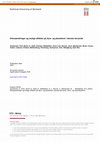
Effekter af klimaforandringer på de danske farvandes oceanografi /Erik Buch Danmarks Meteorologis... more Effekter af klimaforandringer på de danske farvandes oceanografi /Erik Buch Danmarks Meteorologiske Institut. Øget vaekst af planktonalger i havet som en følge af klimaaendringer /Anders Eriksen, Kim Gustavson, Karen Edelvang, Klavs Bundgaard og Kristine Garde, DHI-Institut for Vand og Miljø. Klimaeffekter på stenrevs vegetation /Karsten Dahl, Danmarks Miljøundersøgelser. Effekter af klimaaendringer på makroalger og ålegraes i danske farvande /Anne Lise Middelboe og Jens Borum, Ferskvandsbiologisk Lab., Københavns Universitet. Mulige effekter af temperaturstigninger på fødegrundlaget for fisk i havet. /Flemming Møhlenberg og Kim Gustavson, DHI-Institut for Vand og Miljø, Sten-Åke Wängberg, Göteborg Universitet. Øget sandsynlighed for iltsvind i danske farvande-negative effekter på bunddyr og bundlevende fisk./Kim Gustavson og Flemming Møhlenberg, DHI-Institut for Vand og Miljø. Effekten af klimaaendringer på fisk i farvandene omkring Danmark. /Brian R. MacKenzie og Andre W. Visser, Danmarks Fiskeriundersøgelser. Klimaaendringer og mulige effekter på rastende bestande af vandfugle. /Preben Clausen, DMU, Afdeling for Kystzoneøkologi. Notat af 7/2-2001 indsat af Skov-og Naturstyrelsen.
... and N20) known to be hazardous to the stratospheric ozone layer are increasing due to anthrop... more ... and N20) known to be hazardous to the stratospheric ozone layer are increasing due to anthropogenic activities (Acevedo and Nolan 1993, Prinn 1994). Even during periods of depletion, the thickness of the ozone layer are fluctuating daily (Frederick and Lubin 1994) which ...
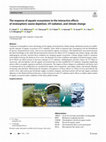
Photochemical & Photobiological Sciences
Variations in stratospheric ozone and changes in the aquatic environment by climate change and hu... more Variations in stratospheric ozone and changes in the aquatic environment by climate change and human activity are modifying the exposure of aquatic ecosystems to UV radiation. These shifts in exposure have consequences for the distributions of species, biogeochemical cycles, and services provided by aquatic ecosystems. This Quadrennial Assessment presents the latest knowledge on the multi-faceted interactions between the effects of UV irradiation and climate change, and other anthropogenic activities, and how these conditions are changing aquatic ecosystems. Climate change results in variations in the depth of mixing, the thickness of ice cover, the duration of ice-free conditions and inputs of dissolved organic matter, all of which can either increase or decrease exposure to UV radiation. Anthropogenic activities release oil, UV filters in sunscreens, and microplastics into the aquatic environment that are then modified by UV radiation, frequently amplifying adverse effects on aqua...
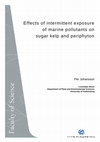
Pollution in the natural aquatic environment is erratic and manifests as temporary increments of ... more Pollution in the natural aquatic environment is erratic and manifests as temporary increments of chemical concentrations, pulses. Traditional ecotoxicological testing does not consider intermittent exposures and does not consider the post-exposure period even though latent effects may occur. Sugar kelp (Saccharina latissima, L.) was exposed to pulses of seven antifouling compounds with different mechanisms of action and marine periphyton were exposed to pulses of a photosystem-II inhibitor and a sterol synthesis inhibitor. Effects of pulsed exposure that did not appear until after the end of exposure were observed in both systems. The pollution history of periphyton communities was found to alter the effect of the exposure of both irgarol and clotrimazole but with dissimilar consequences. Even brief pulses of chemical pollution needs to be considered as latent effects may appear. Sequences of pulsed exposures are hypothesised to differ in toxicity depending on whether the ecological...
Eos, 2019
A coordinated effort involving trailblazing science—and icebreaking ships—from many nations is ne... more A coordinated effort involving trailblazing science—and icebreaking ships—from many nations is needed to fill gaps in our understanding of the Arctic Ocean and how it’s changing.
ASTM International eBooks, Feb 12, 2009

Journal of Plankton Research, 1999
The impact of enhanced and reduced UVB radiation (UVBR) on pelagic ecosystems was studied during ... more The impact of enhanced and reduced UVB radiation (UVBR) on pelagic ecosystems was studied during two mesocosm experiments in May and June/July 1994. The ambient UVBR exposure was either reduced with mylar foil or artificially enhanced with UVB fluorescent tubes. Developments in the phytoplankton communities were followed during 11 and 8 day periods using several structural and functional parameters. In the May experiment, enhanced UVBR significantly stimulated carbon dioxide fixation, activity of alkaline phosphatase and content of fatty acids. In the June-July experiment, the effects induced by changed UVBR were smaller with some indications of decreased algal biomass with enhanced UVBR. Several of the measured parameters indicated that the two experiments represented different stages in the plankton community development. In the May experiment, the community was in a development stage, moving from nutrient-replete to nutrient-depleted conditions, while the community in June/July was depleted of nutrients from the start. The stimulating effects of UVBR in May are suggested to be the secondary effects of a photochemically induced breakdown of dissolved organic matter, resulting in an increase in available nutrients.

The Ecosystem of Kongsfjorden, Svalbard, 2019
This book summarizes physical and biological aspects from Kongsfjorden (78° 59’ N, 11–12° E), Sva... more This book summarizes physical and biological aspects from Kongsfjorden (78° 59’ N, 11–12° E), Svalbard. The contributions to this volume cover atmospheric conditions above Ny-Alesund, as well as physical conditions in Kongsfjorden. The chapters about oceanographic dynamics and sea ice conditions are based on time-series observations of interannual variability, whereas the chapter about the underwater light regime focuses on seasonal dynamics. The pelagic system is covered by reviews of pelagic production, phytoplankton and zooplankton communities. Benthic flora studies address microphytobenthos and macroalgal biodiversity, as well as the physiology of kelp related to stress perception and responses. Benthic fauna communities are described with associated environmental drivers of change. An outline of an Arctic fjord ecosystem model for Kongsfjorden- Krossfjorden is presented. Data that go into models come from sampling at different stations in the marine environment, with an important contribution from long-term data series at stations. Some of the long-term data are based on recordings from autonomous underwater observatories. Finally, one summary presents Kongsfjorden as harbinger of the future Arctic.
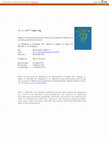
Marine Chemistry, 2012
Recent studies demonstrate that volcanic ash has the potential to increase phytoplankton biomass ... more Recent studies demonstrate that volcanic ash has the potential to increase phytoplankton biomass in the open ocean. However, besides fertilizing trace metals such as Fe, volcanic ash contains a variety of potentially toxic metals such as Cd, Cu, Pb, and Zn. Especially in coastal regions closer to the volcanic eruption, where ash depositions can be very high, toxic effects are possible. Here we present the first results of laboratory experiments, showing that trace metal release from different volcanic materials can have both fertilizing and toxic effects on marine phytoplankton in natural coastal seawater. The diatom Thalassiosira pseudonana generally showed higher growth rates in seawater that was in short contact with volcanic ash compared to the controls without ash addition. In contrast to that, the addition of volcanic ash had either no effect or significantly decreased the growth rate of the coccolithophoride Emiliania huxleyi. It was not possible to attribute the effects to single trace metals, however, our results suggest that Mn plays an important role in regulating the antagonistic and synergistic effects of the different trace metals. This study shows that volcanic ash can lead to changes in the phytoplankton species composition in the high fallout area of the surface ocean.

Journal of Plankton Research, 2000
The impact of UV-B radiation (290-315 nm) on bacterial activity and abundance in coastal water wa... more The impact of UV-B radiation (290-315 nm) on bacterial activity and abundance in coastal water was studied in mesocosm experiments in May 1994 and May 1995 at Kristineberg Marine Research Station, Sweden. Mesocosms (6 m 3) containing natural pelagic communities were exposed either to ambient irradiation (AMB), ambient irradiation with enhanced UV-B (+UV) (0.7 W m-2 4 h every day around noon), or ambient irradiation screened for UV-B (-UV). Bacterial activity in the mesocosms was measured by means of thymidine incorporation in short-term tests during incubations at ambient irradiation, at ambient irradiation with enhanced UV-B, and at ambient irradiation screened for UV-B. In +UV mesocosms, bacterial activity was significantly stimulated when incubated at ambient radiation. The stimulating effect was suggested to be due to an increase in carbon or nutrient supply through a photodegradation of recalcitrant dissolved organic material (DOM). Low attenuation coefficients for UV-B and PAR (400-700 nm) in the +UV mesocosms supported this hypothesis. The bacterial activity in +UV mesocosms, however, was inhibited when incubations were made at enhanced UV-B irradiation, implying that the bacteria had become more sensitive to UV-B radiation. The increased sensitivity to UV-B exposure in bacterial assemblages that already had been exposed and stressed by UV-B radiation is suggested to be due to an overburdening of the energyconsuming DNA repair mechanism. The data suggest that increased UV-B radiation, which might occur with ozone depletion, may both stimulate and suppress bacterial activity in coastal waters, implying that the net outcome of enhanced UV-B radiation could be an unchanged bacterial activity.
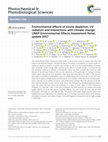
Photochemical & photobiological sciences : Official journal of the European Photochemistry Association and the European Society for Photobiology, Jan 14, 2018
The Environmental Effects Assessment Panel (EEAP) is one of three Panels of experts that inform t... more The Environmental Effects Assessment Panel (EEAP) is one of three Panels of experts that inform the Parties to the Montreal Protocol. The EEAP focuses on the effects of UV radiation on human health, terrestrial and aquatic ecosystems, air quality, and materials, as well as on the interactive effects of UV radiation and global climate change. When considering the effects of climate change, it has become clear that processes resulting in changes in stratospheric ozone are more complex than previously held. Because of the Montreal Protocol, there are now indications of the beginnings of a recovery of stratospheric ozone, although the time required to reach levels like those before the 1960s is still uncertain, particularly as the effects of stratospheric ozone on climate change and vice versa, are not yet fully understood. Some regions will likely receive enhanced levels of UV radiation, while other areas will likely experience a reduction in UV radiation as ozone- and climate-driven c...
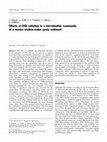
Marine Biology, 1998
The role of ambient and enhanced ultraviolet-B radiation (UVB; 280 to 315 nm) in a natural sand-a... more The role of ambient and enhanced ultraviolet-B radiation (UVB; 280 to 315 nm) in a natural sand-associated microbenthic community was studied in a 3-week experiment by incubating intact sediment cores from a shallow bay in an outdoor¯ow-through system with 27 aquaria. After sampling of initial cores, the remaining cores (one per aquarium) were given one of three treatments: no, ambient, and moderately enhanced UVB, and sampled, nine at a time, after 5, 12, and 19 d. The response of the community was studied by analysing algal and meiofaunal composition and biomass, chlorophyll a content, composition of pigments and fatty acids, and content of UV-absorbing compounds (state variables), as well as carbon ®xation and allocation, and bacterial productivity (rate variables). Among rate variables, signi®cant eects of UVB-treatments were found for carbon ®xation and allocation, while bacterial productivity was not aected. For state variables, a signi®cant response was observed for the composition of microalgae and fatty acids, and for chlorophyll a content. The eect of treatments was mainly observed as dierences in development with time (two-way analysis of variance, treatment´time interaction). Towards the end of the experiment, the no-UVB treatment most often diered from one or both of the two treatments with UVB exposure, the latter showing lower values. There were marked successional changes in the community, irrespective of treatment. The microalgal community changed from being dominated by coccoid cyanobacteria and epipsammic diatoms to a dominance of epipelic diatoms and ®lamentous cyanobacteria. The pattern of carbon allocation, as well as an increased C/N ratio of the sediment, suggested limitation of growth, perhaps by nutrients, at the end of the experiment. This may possibly have acted synergistically with UVB exposure to create the treatment eects. The new knowledge gained from our experiment is that ambient UVB can exert a stress on the function of sand-associated microbenthic communities in shallow waters and that this eect coincides with structural dierences in the community. More experiments in natural or semi-natural systems are needed to allow better prediction of microbenthic community-level responses to UVB.
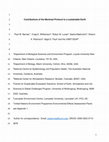
Nature Sustainability, 2019
Thirty-three years ago, an unprecedented thinning of stratospheric ozone was reported over Antarc... more Thirty-three years ago, an unprecedented thinning of stratospheric ozone was reported over Antarctica 1. In response to concerns about elevated exposure to solar ultraviolet-B radiation (UV-B; wavelengths 280-315 nm) resulting from ozone depletion, the international community mobilized and worked together to understand the causes and find a solution to this dramatic change in Earth's environment. The policy solution that emerged to address this global environmental problem was the 1985 Vienna Convention for the Protection of the Ozone Layer. In this international agreement the United Nations recognized the fundamental importance of preventing the damaging effects of stratospheric ozone depletion, whether on human health or the environment. This convention was followed by the 1987 Montreal Protocol on Substances that Deplete the Ozone Layer with its subsequent amendments, adjustments, and decisions that were negotiated to control the consumption and production of anthropogenic ozone-depleting substances, including chlorofluorocarbons (CFCs). The Montreal Protocol now has the unique distinction of being the only treaty, ever, of any type, ratified by all 197 countries of the United Nations. The Parties to the Montreal Protocol base their decisions on scientific, environmental, technical, and economic information provided by three assessment Panels (Box 1). All three panels provide full assessment reports to the Parties every four years (quadrennial reports) and shorter, periodic updates in the intervening years as needed. The implementation of the Montreal Protocol has successfully prevented the uncontrolled global depletion of the stratospheric ozone layer 2,3. Concentrations of ozonedepleting substances have been declining in the stratosphere since the late 1990s. While significant seasonal ozone depletion over Antarctica has occurred annually since the 1980s (called the "ozone hole"), there have been small, but significant, positive trends in total column ozone in Antarctica in spring over the period 2001-2013. Global mean total ozone has been projected to recover to pre-1980 levels by about the middle of the 21 st century, assuming full compliance to the Montreal Protocol 2. Many of the chemical compounds controlled by the Montreal Protocol are not only involved in depletion of stratospheric ozone, but are also potent greenhouse gases 4. Modeling studies indicate that, in the absence of the Montreal Protocol, global mean temperatures would have risen by more than 2C by 2070, due to the warming effects from ozone-depleting substances alone 5. The adoption of the Kigali Amendment to the Montreal Protocol in 2016 limits the production and consumption of hydrofluorocarbons (HFCs), powerful greenhouse gases that are used as substitutes to ozone-depleting substances. This amendment has further broadened and strengthened the scope of the Montreal Protocol, creating an effective international treaty that not only addresses stratospheric ozone depletion, but is doing more to mitigate global climate change than any other human actions to date 7-10. One of the important reasons for the success of the Montreal Protocol has been its foundation on high quality science, which not only improves our understanding of the causes and mechanisms of ozone depletion, but also of the environmental effects of these atmospheric changes. The Environmental Effects Assessment Panel (EEAP) is specifically charged with providing regular assessments of the state of the science on the environmental effects of ozone depletion and consequent changes in UV radiation at Earth's surface, and the interactive effects of climate change (Box 1 and Fig. 1). Here, we summarize key findings from the most recent EEAP Quadrennial Assessment, and consider the significant policy and societal implications of these environmental effects. We specifically highlight the multiple ways by which the Montreal Protocol is contributing to environmental sustainability and human health and well-being consistent with many of the United Nations Sustainability Goals (Box 2). More in-depth information on ozone depletion and its environmental effects can be found in the full Assessments published by the Ozone Secretariat of the United Nations Environment Programme (https://ozone.unep.org) and elsewhere (Photochemical & Photobiological Sciences journal) 11-17. By focusing on the interactions between stratospheric ozone dynamics, UV radiation, and climate change, the report from the EEAP complements that of the UN's Intergovernmental Panel on Climate Change (IPCC;https://www.ipcc.ch; summarized by Pachauri, et al. 18) to provide a comprehensive assessment on the environmental effects of global changes in Earth's atmosphere.
Photochemical & Photobiological Sciences, 2019
Summary of current knowledge about effects of UV radiation in inland and oceanic waters related t... more Summary of current knowledge about effects of UV radiation in inland and oceanic waters related to stratospheric ozone depletion and climate change.

Uploads
Papers by Sten-Åke Wängberg